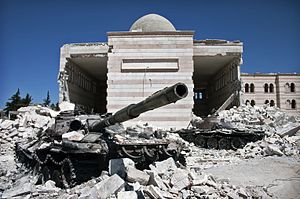
The Free Syrian Army is a big-tent coalition of decentralized resistance militias in the Syrian Civil War founded on 29 July 2011 by Colonel Riad al-Asaad and six officers who defected from the Syrian Armed Forces. The officers announced that the immediate priority of the Free Syrian Army was to safeguard the lives of protestors and civilians from the deadly crackdown by Bashar al-Assad's security apparatus; with the ultimate goal of accomplishing the objectives of the Syrian revolution, namely, the end to the decades-long reign of the ruling al-Assad family. In late 2011, the FSA was the main Syrian military defectors group. Initially a formal military organization at its founding, its original command structure dissipated by 2016, and the FSA identity has since been used by various Syrian opposition groups.
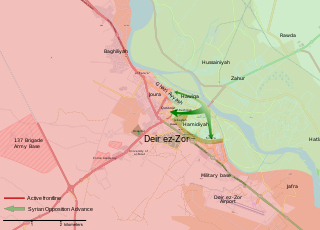
Protests against the Syrian government and violence had been ongoing in the Syrian city of Deir ez-Zor since March 2011, as part of the wider Syrian Civil War, but large-scale clashes started following a military operation in late July 2011 to secure the city of Deir ez-Zor. The rebels took over most of the province by late 2013, leaving only small pockets of government control around the city of Deir ez-Zor.

The 2012 Aleppo Governorate clashes were a series of battles as part of the early insurgency phase of the Syrian civil war in the Aleppo Governorate of Syria.

The first of the two battles in al-Qusayr was fought by the Syrian army and Shabiha against the Free Syrian Army in the small city of Al-Qusayr, near Homs, during late winter and spring of 2012.

The al-Tawhid Brigade, named after Tawhid, the "oneness of God," was an armed Islamist insurgent group involved in the Syrian Civil War.

The Battle of Anadan was a ten-hour-long armed confrontation between the rebels of the Free Syrian Army and soldiers of the Syrian Army that occurred when FSA forces attempted to overrun a large army checkpoint in the Anadan area. At the end of the battle, FSA fighters successfully seized the checkpoint.

The June 2012–April 2013 Idlib Governorate clashes was a series of clashes within the scope of the Syrian civil war, that took place in Syria's Idlib Governorate. The events followed the April 2012 Idlib Governorate Operation by the Syrian government and consequent cease-fire attempt, which had lasted from 14 April to 2 June 2012.
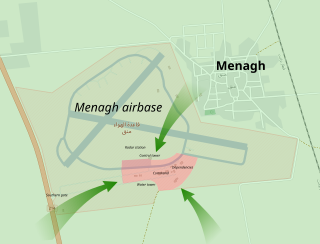
The siege of Menagh Air Base was an armed confrontation between the Syrian Armed Forces and the Free Syrian Army and aligned Islamist opposition groups during the Syrian civil war

The Kurdish Front is a predominantly Kurdish Syrian rebel faction participating in the Syrian Civil War.

The Northern Storm Brigade, also known as the Northern Hurricane Brigade, is a Syrian rebel group formed in 2011 and based in Azaz in northwestern Syria, near the border with Turkey. The leader and other members of the group were smugglers from Azaz and its surroundings before the Syrian Civil War. The group retained exclusive control of the Bab al-Salam border crossing.

The Nour al-Din al-Zenki Movement was a Sunni Islamist rebel group involved in the Syrian Civil War. In 2014, it was reportedly one of the most influential factions in Aleppo, especially the Western Aleppo countryside. Between 2014 and 2015, it was part of the Syrian Revolutionary Command Council and recipient of U.S.-made BGM-71 TOW anti-tank missiles. The Movement made multiple attempts to merge with the larger Islamist rebel group Ahrar al-Sham but were refused by Ahrar al-Sham's leadership. The Zenki Movement also made attempts to merge with other Islamist factions, Jaysh al-Islam and the Sham Legion. However, all merging efforts with these groups failed, leading to the Zenki Movement joining the Salafi Islamist Hayat Tahrir al-Sham (HTS) in 2017. But after a few months the group left HTS and within a year went to war with HTS by joining the Turkish-backed Syrian Liberation Front alongside Ahrar al-Sham on 18 February 2018. After a series of clashes in early 2019 Al Zenki were largely defeated by HTS, expelled to Afrin and absorbed in the Turkish-backed Syrian National Army. However, it reportedly re-emerged as an independent entity in 2020.
Relations between the People's Protection Units (YPG) and the Free Syrian Army (FSA) are unclear and varied among the different FSA factions. Both are opposed to the Islamic State of Iraq and the Levant. However, several clashes between the two have taken place. Under pressure from the United States, some FSA groups coordinate with the YPG to battle ISIL under the name of the Syrian Democratic Forces, although some other FSA groups remained in conflict with the YPG and the SDF, including FSA groups in the SDF.
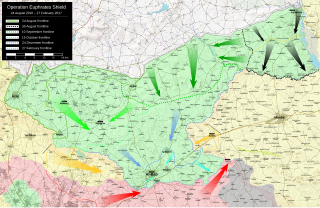
Operation Euphrates Shield was a cross-border military operation conducted by the Turkish Armed Forces in the Syrian Civil War which led to the Turkish occupation of northern Syria. Operations were carried out in the region between the Euphrates river to the east and the rebel-held area around Azaz to the west. The Turkish military and Turkey-aligned Syrian rebel groups, some of which used the Free Syrian Army label, fought against the forces of the Islamic State (IS) as well as against the Syrian Democratic Forces (SDF) from 24 August 2016. On 29 March 2017, the Turkish military officially announced that Operation Euphrates Shield was "successfully completed".
Al-Rai, is a small town in northern Aleppo Governorate, northern Syria. With 4,609 inhabitants, as per the 2004 census, al-Rai is the administrative center of the sparsely populated Nahiya al-Rai. Located on the Istanbul-Baghdad Railway and close to the Turkish border, right across Elbeyli, it is however a strategically important village. The town of Akhtarin, some 15 kilometers (9.3 mi) to the southwest. Larger towns are Azaz, some 35 kilometers (22 mi) to the west, and Jarablus and Manbij, both some 45 kilometers (28 mi) to the east.
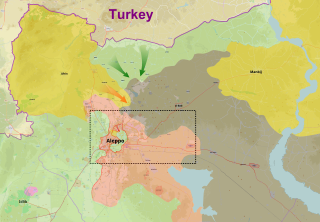
The 2016 Dabiq offensive was a military offensive and part of the third phase of Operation Euphrates Shield launched by the Turkish Armed Forces and factions from the Free Syrian Army and allied groups, with the goal of capturing the town of Dabiq, north of Aleppo from Islamic State in Iraq and the Levant (ISIL). It began in September and resulted in the capture of Dabiq by Turkish/FSA-allied forces on 16 October.
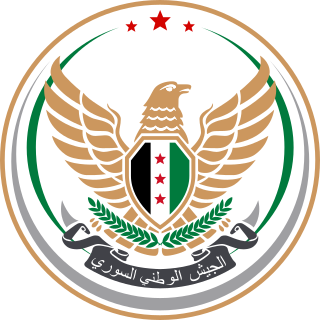
The Syrian National Army, previously the Free Syrian Army (FSA) and also known as the Turkish-backed Free Syrian Army (TFSA), is a coalition of armed Syrian opposition groups in the Syrian Civil War. Comprising various rebel factions that emerged at the onset of the war in July 2011, it was officially established in 2017 under the auspices of Turkey, which provides funding, training, and military support.

The Northern Aleppo offensive was a military offensive launched by armed Syrian opposition forces led by the Free Syrian Army against the Islamic State of Iraq and the Levant in the northern Aleppo Governorate. The offensive resulted in ISIL's withdrawal from the city of Azaz, Menagh Military Airbase, and a number of towns and villages in the area.

The Conquest Brigade, also known as Battalion of Conquest or al-Fatah Brigade, is a Sunni Islamist Free Syrian Army group that takes part in the Syrian Civil War. One of the largest rebel factions active in Aleppo Governorate during the early civil war, the militia played a major part in the fighting for Aleppo city and other battles. As result of conflicts with government forces and later the Islamic State of Iraq and the Levant it declined after 2013.The Conquest Brigade became part of the Turkish-backed Free Syrian Army (TFSA) in 2016, also engaging in fighting with the Syrian Democratic Forces.
Opposition–ISIL conflict during the Syrian Civil War started after fighting erupted between Syrian opposition groups and the Islamic State of Iraq and the Levant (ISIL). In early January 2014, serious clashes between the groups erupted in the north of the country. Opposition groups near Aleppo attacked ISIL in two areas, Atarib and Anadan, which were both strongholds of the fundamentalist Sunni organization. Despite the conflict between ISIL and other rebels, one faction of ISIL has cooperated with the al-Nusra Front and the Green Battalion to combat Hezbollah in the Battle of Qalamoun. By 2018.
